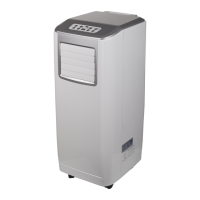
Do you have a question about the Addvent AVAC9000 and is the answer not in the manual?
| power supply | 220-240V~, 50Hz |
|---|---|
| power consumption | 1020W/4.5A |
| cooling capacity | 9000BTU/2.65KW |
|---|---|
| compressor type | rotary |
| refrigerant | R-410A |
| working temperature | 18 oC-32oC |
|---|---|
| fan speed | 2 |
| timer | 1~24 hours |
| net weight | 20.3 kg |
|---|---|
| product size | 317 x 402 x 770 mm |
| exhaust pipe size | Ø 142 x 1500 mm |
Basic safety measures to follow when using any electrical appliance, read instructions carefully.
Explains device symbols and notes the use of Propane gas R290, requiring adherence to manufacturer instructions.
Emphasizes reading the entire manual before use and adhering to minimum room size requirements for operation.
Details age-specific usage rules for children and requires adult supervision for maintenance.
Covers intended use, cord integrity, unit orientation, airflow, electrical connections, and avoiding hazards.
Specifies indoor use, avoiding wet areas, maintaining upright position during transport, and post-unpacking stabilization.
Notes warranty exclusion for non-compliance and provides caution for safe disposal of packaging materials.
Highlights R290 as flammable and outlines precautions for handling and avoiding damage to the cooling circuit.
Details safe storage conditions, ventilation needs, room area requirements, and qualifications for refrigerant handling.
Lists and visually identifies the main functional parts of the air conditioner unit.
Lists and visually identifies the accessories provided with the air conditioner for installation and operation.
Guides the installation of the exhaust hose to an outside area and sealing window gaps with extendable slides.
Provides step-by-step instructions for using extendable slides to secure the window and exhaust hose connection.
Advises on proper hose attachment, avoiding kinks, length optimization, and warnings against unauthorized hose modifications.
Details the process of removing the filter frame, inserting the active carbon filter, and refitting the frame.
Explains the purpose of each button and indicator light on the control panel.
Instructs on opening and adjusting the horizontal louvers for desired air direction.
Describes how to turn the unit on/off and details the logic of the automatic mode based on ambient temperature.
Notes that the display window shows the current ambient room temperature from 0°C to 50°C.
Explains how to select modes (auto, cool, fan, dry) and adjust temperature, fan speed, and timer settings.
Details how to activate the sleep function in cooling mode, including temperature and fan speed adjustments.
Covers sleep function duration limits and explains the operation of the Dehumidify (DRY) mode including water collection.
Describes self-diagnosis codes, remote control usage, and essential operational notes for compressor longevity.
Explains how water is extracted, what happens when the reservoir is full, and the associated indicators.
Provides step-by-step instructions for manually draining the water from the unit.
Guides on setting up continuous drainage by connecting a drain tube to bypass manual emptying.
Explains how to extend the drain tube and provides important notes regarding drain level and indicator function.
Instructions for cleaning the exterior of the air conditioner using a soft, damp cloth.
Details how to clean the air filters using vacuuming or water rinsing, and stresses not operating without filters.
Steps for preparing the unit for storage, including draining, cleaning, and packing.
Lists checks for when the air conditioner does not run, including power, indicators, and temperature.
Lists checks for inefficient performance, such as filter status, airflow blockages, and room conditions.
Addresses causes of excessive noise and compressor not running, suggesting checks for positioning and potential overheat protection.
Provides detailed technical specifications including model, power, capacity, dimensions, and weight.
Includes information on waste electrical product disposal and company contact details.